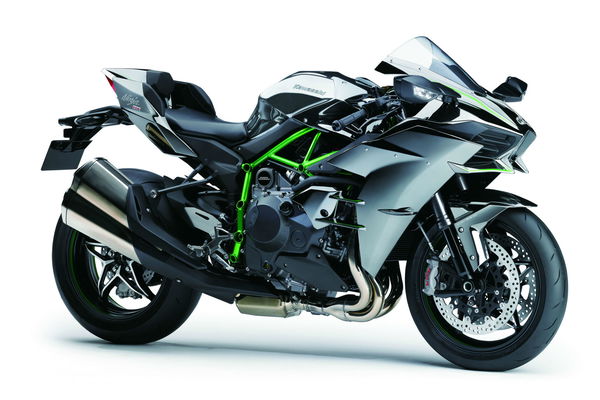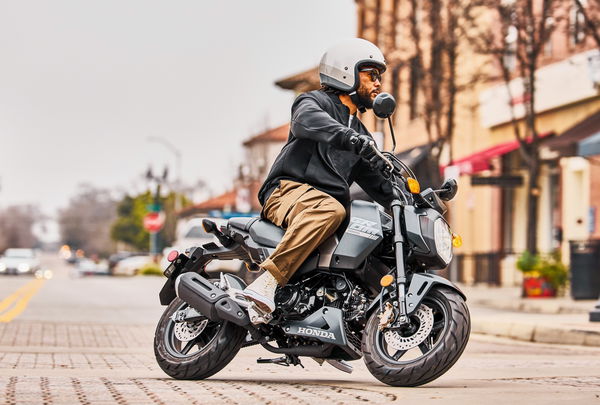Kawasaki Ninja H2 at Eicma
210hp and only minor engine changes for road-legal version of supercharged sports bike


KAWASAKI has just unveiled its new Ninja H2, a 210hp road-going version of the track-only H2R.
The engine has been detuned from the H2R's 300hp-plus to 200hp but hits a claimed 210hp with the benefit of ram-air.
Kerb weight is 238kg, giving the H2 a power-to-weight ratio of 0.88 hp/kg. Peak torque is 98.5lbft.
Kawasaki says the supercharged engine has only received minor changes to meet noise and emission limits and delivers 'acceleration unlike anything you can experience on a naturally aspirated bike'.
The supercharger produces an engine characterstic 'similar to having a wide power band,' according to the firm.
The H2 shares the H2R's steel trellis frame which Kawasaki says allows a short wheelbase for sharp handling while providing excellent high-speed stability. The single-sided swing-arm – Kawasaki's first – bolts directly to the engine, which acts as a stressed member.
The mirrors are designed to aerodynamically assist high-speed stability while a 'chin spoiler' on the fairing delivers downforce to the front wheel.
Electronics include multi-level traction control with a track mode, launch control to maximise acceleration from a standstill and ABS.
It's also got a quick-shifter and an Öhlins electronic steering damper.
The H2 has KYB suspension front and rear with a fully adjustable shock.
The brakes are from Brembo, with 330mm semi-floating discs and radial-mounted monobloc calipers at the front and a 250mm disc at the rear.
Kawasaki says the riding position is slightly less aggressive than typical of a supersports bike, and no pillion seat is provided because 'enjoyment of the intense acceleration and high-speed capabilities was the first priority'.
The paint uses 'a chemical reaction between a solution of silver ions and a reducing agent that forms a layer of pure silver' according to Kawasaki. A first on a production motorcycle, it looks black in the shade but takes on a mirrored-finish in light.
After a teaser campaign lasting months, and the H2R's unveiling in September, the H2 was finally given its first public showing today at Milan's Eicma motorcycle show.
Kawasaki's release said:
'BUILT BEYOND BELIEF
The launching point for the development of the Ninja H2 was a strong desire to offer riders something they had never before experienced. Convinced that a truly extraordinary riding experience would not be found on a motorcycle that merely built on the performance of existing models, the design team committed to developing the “ultimate” motorcycle from a clean slate. The bike needed to deliver intense acceleration and an ultra-high top speed, coupled with supersport-level circuit performance. To realise this goal, help was enlisted from other companies in the Kawasaki Heavy Industries (KHI) Group, precipitating an unprecedented level of inter-company collaboration.
Development pursued two paths. The first was a closed-course model (Ninja H2R) that allowed an unadulterated pursuit of performance free of the limitations that street riding would impose. This was followed by a street model (Ninja H2), based closely on the closed-course model, that would meet all market regulations. The results were incredible, with both models offering a sensory experience surpassing anything that riders can find today.
The Ninja H2 is powered by a supercharged engine based closely on that developed for the over 300 PS Ninja H2R. High output notwithstanding, the compact design is on par with power units found in supersport litre-class models. The key to achieving this incredible performance lies in the engine’s supercharger—a motorcycle-specific unit designed completely in-house with technology from the Gas Turbine & Machinery Company, Aerospace Company and Corporate Technology Division.
KHI Group technology was not limited to the supercharger. Advanced technological know-how shared from other group companies is found throughout the innovative engine and chassis designs. For example, the aerodynamic mirror stays that add stability for high-speed riding were designed with assistance from Kawasaki’s Aerospace Company. This is only one of many examples, but such inter-company collaboration and the level of resultant technology poured into this model is the reason the Kawasaki River Mark* is displayed prominently on the upper cowl.
When it came time to name this model, using “Ninja”—a name synonymous with Kawasaki performance and shared by many legendary models over the years—was an obvious choice. But it is also named for another epoch-making model: the “H2” (also known as the 750SS Mach IV), powered by a 2-stroke 748 cm3 Triple, had an intense acceleration that made it a worldwide sensation. For a model that delivers supersport-level handling coupled with the kind of acceleration no rider has experienced before, we can think of no better name.
With the Ninja H2, Kawasaki is once again ready to unleash a new sensation upon the world.
*The Kawasaki River Mark is a long-time symbol of the KHI Group dating back to the 1870s. As a policy, its use on products is rare and limited to models with historical significance. But for the Ninja H2 permission to use this symbol was granted.
THE QUEST FOR POWER
In order to be able to offer intense acceleration, it was essential that the engine be able to produce big power. While a large-displacement engine could easily provide a high engine output, to ensure a lightweight, compact overall package a compact engine was also desired. Using a supercharged engine enabled both of these engine design requirements to be met: the Ninja H2 has a maximum output of 200 PS and its engine size is on par with other supersport litre-class power units. Aside from minor differences in the engine unit, and intake and exhaust systems tailored for street use to ensure it meets noise and emissions standards, the supercharged engine is essentially the same as the over 300 PS engine of the closed-course Ninja H2R, delivering an intense acceleration unlike anything you can experience on a naturally aspirated bike. Designed in-house, the immense potential of the highly compact, highly efficient engine is a testament to the technology possessed by the KHI Group.'
SPECIFICATIONS
| ENGINE | ZX1000NFF |
Type Displacement Bore and Stroke Compression ratio Valve system Fuel system Intake system Ignition Starting Lubrication | Liquid-cooled, 4-stroke In-Line Four 998 cm3 76.0 x 55.0 mm 8.5:1 DOHC, 16 valves Fuel injection: φ50 mm x 4 with dual injection Kawasaki Supercharger Digital Electric Forced lubrication, wet sump with oil cooler |
| DRIVETRAIN | |
Transmission Final drive Primary reduction ratio Gear ratios: 1st 2nd 3rd 4th 5th 6th Final reduction ratio Clutch | 6-speed, return, dog-ring Chain 1.551 (76/49) 3.188 (51/16) 2.526 (48/19) 2.045 (45/22) 1.727 (38/22) 1.524 (32/21) 1.348 (31/23) 2.444 (44/18) Wet multi-disc, manual |
| FRAME | |
Type Wheel travel: front rear Tyre: front rear Caster (rake) Trail Steering angle (left/right) | Trellis, high-tensile steel, with Swingarm Mounting Plate 120 mm 135 mm 120/70ZR17M/C (58W) 200/55ZR17M/C (78W) 24.5o 103 mm 27o / 27 |
| SUSPENSION | ZX1000NFF |
Front: Type Rear: Type | φ43 mm inverted fork with rebound and compression damping, spring preload adjustability and top-out springs New Uni-Trak with gas-charged shock, piggyback reservoir, |
| BRAKES | |
Front: Type Caliper Rear: Type Caliper | Dual semi-floating φ330 mm discs Dual radial-mount, opposed 4-piston Single φ250 mm disc Opposed 2-piston |
| DIMENSIONS | |
Overall length Overall width Overall height Wheelbase Ground clearance Seat height Curb mass Fuel capacity | 2,085 mm 770 mm 1,125 mm 1,455 mm 130 mm 825 mm 238 kg 17 litres |
| PERFORMANCE | |
Maximum power Maximum power with Ram Air Maximum torque | 147.2 kW {200 PS} / 11,000 min-1 154.5 kW {210 PS} / 11,000 min-1 133.5 N?m {13.6 kg??m} / 10,500 min-1 |











